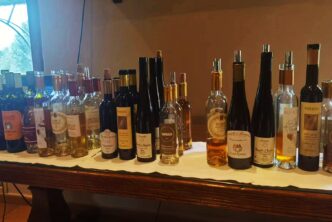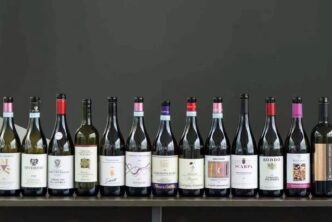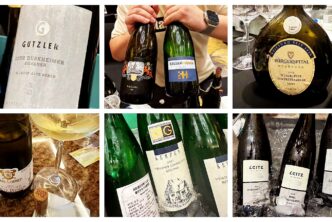Small-batch (also referred to as small-lot) wines can be produced for a slew of different reasons, but the one stable characteristic they all share is their number: they are essentially made in small volumes only. Definitions vary, but there usually need to be less than 1000 cases of small-lot wines made annually for a wine to qualify as such (by contrast, a small-production wine means less than 49,000 cases/year, which in all honesty hardly seems like “small production” to me). In fact, volumes of small-batch wines are often much smaller than even the “less than 1000 cases” amount often cited as a potential definition. For example, in this article, you will read about wines made in as few as 1000 bottles a year, not cases (though most of the wines in this article are made in slightly larger numbers than that). Problem is, buy just one bottle and when you might want more later because you really like the wine (when you finally got around to opening the bottle), and you might well be out of luck, given the downright paltry quantities made.
So why are small-batch wines made? For one, they are an excellent way to study specific terroirs. Making wine from small plots of land can really bring to the fore the single grape variety that grows there; even better, it’s a great way to try and make wines from different old biotypes and discover what each can really deliver. Clearly, this is something that would be completely lost if the grapes were grown as a field blend or were all blended together after having been picked in different plots of land to make one wine. Small-batch wine are also a means by which to study the characteristics of a specific soil or water regimen of a vineyard, and even of its microclimate.
Clearly, with small-batch wines, the scale of production inevitably affects the end-product. I mean, it’s one thing to machine-harvest and quite another to pick the grapes by hand: but I wonder, can you really pick grapes by hand when you’re making half a million, a million bottles or even more of that wine a year? It follows that small batch wines, made from small plots of land, are often (but not always, and that needs to be remembered) the domain of small wineries, which allows for greater biodiversity not just in the vineyards and in your glass, but on store shelves too. To paraphrase Monty Python, big landowners and cooperatives control “huge tracts of vineyard land” and can produce wine in very cost-effective manner, something that the little guys cannot really do. It’s not realistic. This is perhaps why a study by Michigan State University once highlighted how about 51% of the wines available for sale in the United States of America were owned by three companies: Constellation Brands, E&J Gallo, and The Wine Group. In the interest of diversity, that might not be such a good thing. But to be clear, small does not necessarily mean better: while it is true that farming smaller vineyards should (in theory at least) allow the grower to have more hands-on control (literally, you might say) and therefore allow him or her to oversee the whole wine production process with greater attention to detail, as always it boils down to the individual and what his or her talent levels, willingness to expend elbow grease, and even ethics, are. After all, I’ve seen smallish producers in southern Italy bottling Pinot Grigio wines (and I don’t mean producers with vineyards at 2000 meters above sea level): and yes, southern Italy is too hot for that low acid variety. Besides, one of the wineries I’m thinking about didn’t even own any Pinot Grigio vines. So although there is usually more than just a grain of truth in the “less is more” statement, that’s not always the case. So trying to buy wine on a “small batch” basis making the assumption of it being always better than a well-made wine produced in much larger volumes might not be so prudent.
So how to go about in choosing the right small lot wine? Fortunately, I have done the leg work for you and have written up this long report on such wines from Italy (in fact, so long that I have divided it into two parts: This is part 1, and part 2 will be out next Friday, with each part featuring at least twenty different wineries). I have chosen to focus on Italian wines only for this report as Italy is the country I spend most of my time in visiting wineries (however, I am in France as much as two months a year as well, and so I will be soon writing about French small batch wines too). In this tasting report, I tackle very small to smallish wineries and their wines, made from many different grape varieties and many different regions, territories and terroirs.
The wines in this tasting report
This report focuses on the wineries featured at Micro Mega Wines (MMW), the thematic area in Hall C at the Vinitaly fair, held annually in Verona each year. I am the one who created this specific wine area at the fair’s request, as I believe it is an excellent way by which for all of us to meet new producers and taste potentially great new wines. At the same time, MMW gives these small wineries, often just starting out, an opportunity to showcase their wines to international wine professionals they might not otherwise be able to reach. Clearly, a note of merit must go to Vinitaly Area manager Gianni Bruno who didn’t kick me out of the room when I first proposed the idea to him (now over there years ago): after all, fairs aren’t in the business of giving away tables and stands at a lower cost than anticipated, so it really is to his and the fair’s credit that they were willing to do something for the Italy’s wine small-fry (clearly, the stands at MMW are not as big as, and are more spartan, than those of wineries paying top dollar (aka. the regular price) for the regular stands. This year, the MMW space featured a plethora of super-interesting producers, including one wine from the Mandrolisai area of Sardinia (La Dolce Vigna); one of only five or six producers (Bentu) currently making wine from the Arvesiniadu grape (another rare native of Sardinia); a brand new Zibibbo wine that is already turning heads (Mustrazzavini); the best producer of the Marche’s excellent Ribona wines (Podere Sabbioni); one of Italy’s best wineries the wines of which are sought after by collectors and multi-starred restaurants all over the world (Tiberio); an up and coming estate of Franciacorta making super-interesting bubblies (Gralò Franciacorta); the only producer in Italy, to the best of my knowledge, of a classically dry Moscato Nero wine (Valdisole); an outstanding producer of a white wine from Puglia’s Valle dell’Itria made with the local grapes that is not just of jaw-dropping goodness but also, for many different reasons, of noteworthy significance (Lasorte Cuadra); one of the best, most famous and historic names in Friuli (Oslavia, really) orange wine production (Primosic); one of the less than a handful producers of Italian wine made with the Marselan grape variety (Redalmo); the group of producers belonging to the Mamojà association, producers of a Cannonau wine quite unlike any other and who presented their new viticultural-geographic map of their area, identifying six different subzones within their territories each of which are associated with equally good if logically different wines (in the same way that has been done with the contrade of Etna and in Barbaresco and Barolo with their vineyard districts). And much more still, but you probably imagined that without my having to tell you. (Once again, please note that any winery I might have alluded to above that you do not find within this article will be featured in next week’s part 2.) Cheers!
All’Insú.
All’Insú 2021 Albugnano Berenices 93+
Bright red with garnet tinges. Very pretty on the nose: clean, fresh red berry (redcurrants, especially) and cherry aromas and flavours, with a vibrant and intense violet topnote further complicated by a hint of red roses: very Nebbiolo! This does not undergo any oak treatment, and is aged for two years in stainless steel only. I was told by Marco Negro, All’Insú’s owner, that his objective is to produce a Albugnano aged in cement tanks, as he believes that oak camouflages the delicate aromas and flavours expressed by Nebbiolo of the Asti area. He will get no argument from me. The Nebbiolo was planted in 2009 on a south-facing slope at 460 meters above sea level, in a forested enclave that guarantees a relatively cool microclimate. Given the relatively young age of the vineyard, it follows that as good as this wine is already, it will only improve in the years to come, which allow me, is really a pretty exciting development. Well done here! All the wines of this winery are named after constellations: Berenices, or more precisely Coma Berenices (Berenice’s Hair, in English), home to the North Galactic Pole, is an ancient asterism (a group of stars smaller than a constellation) in the northern sky which was redefined as one of the eighty-eight modern constellations, most likely by Danish astronomer Tycho Brahe. It is named after the Queen Berenice II of Egypt. Drinking window: 2025-2032.
All’Insú 2021 Barbera d’Asti Cygnus 92
Luminous purple-ruby. Very steely, nuanced, refined wine redolent of raspberry and ripe Morello cherry, with a bright violet topnote. Vinified and aged only in steel, this is made with grapes grown within the Nizza denomination so this could easily be a Nizza. Lovely juicy elegant Barbera that will prove very flexible at the dining table. The wine’s name, “Cygnus” means swan, but the word is really a reference to a constellation clearly visible in the northern sky, linked to Phaeton, Cygnus, and Zeus of Greek mythology, it features a bright asterism of six stars known as the Northern Cross (all the wines at All’Insú are named after groups of stars). Drinking window: 2024-2026.
All’Insú 2020 Barbera d’Asti Superiore Pegasus NR
Damp, musty, and a little tired: this might have been slightly oxidized as it was not a very fresh sample; maybe I just had a bad bottle, so that is why the wine is not scored. I will do my best to taste it again and should it be on a par with all the other good wines made at this estate, I will write it up in one of our Monday “Wines of the Week” section. Drinking window: – –

Annafrancesca.
Annafrancesca Pinot Grigio Metodo Ancestrale Spumante Bianco 91
Orange-pink. Fresh, citrussy aromas of orchard fruits, ginger, white flowers, and honey. Then offers lovely freshness and lift, finishing with a subtle, dusty suggestion of mandarin. Very clean, refreshing and easy to drink. Drinking window: 2024-2025.
Annafrancesca NV Merlot Rosé Spumante Brut Charme 91
Bright pink. Inviting aromas of cumin, orange oil, and balsamic herbs, Suave and sweet with a penetrating quality to the nuanced flavours of ripe dark berries and herbs. Closes nicely juicy and with good length. Drinking window: 2024-2025.
Annafrancesca 2023 Moscato Giallo 92
Lychee ripe tropical fruit spices, very Moscato Giallo. 3.5 hectares planted in 2013. Drinking window:
Annafrancesca 2022 Pinot Grigio Ramato delle Venezie 93
Bright medium pink colour. Inviting aromas of orchard fruit and herbs, with a smattering of floral nuances that provide noteworthy perfumed lift. Slightly chunky and monolithic at first, then opens with aeration to offer enticing small red berries and peach flavours that are clean and bright. Finishes with just a touch of skin contact-related bite. This is a really outstanding skin contact white, with no musty earthy notes and offering instead lots of precise, clean variety-accurate aromas and flavours. Frankly, after just the first sip, I was left thinking that one can only wish more skin contact white wines were like this one. Congratulations: very well done! Drinking window: 2024-2026.
Annafrancesca 2022 Merlot Verona 92
Purple-ruby. Violet, blackcurrant and coffee on the nose and in the mouth. Good fresh, young high-acid Merlot wine that was last made in 2019, but they did well to produce it again in 2022, because this is really rock-solid. Drinking window: 2024-2027.
Annafrancesca 2020 Merlot Riserva Battista Verona 92
Bright full ruby. High-toned aromas of cassis, blackberry and licorice are complemented by chocolate and vanilla. Plush and broad on the palate, with nicely sweet, mouth-filling flavours of black fruits, licorice, dark chocolate and sweet spices, plus a suggestion of camphor. Big, ripe Merlot with impressive persistence made with 100% air-dried grapes (air-dried for 45 days), matured thirteen months in 500 liters American oak barrels and two years in bottle prior to going on sale. Drinking window: 2025-2030.
Antonio Mele.
Is Antonio Mele the best producer of Granazza wines? I think so: at the very least, he is able to fashion, in almost every vintage a crisp clean white wine that speaks of the variety and makes you want to finish the bottle before anyone else can join you at the table. For sure, the 2023 Granazza is a worthy successor to the outstanding 2022. You know how there are some winemakers that seem to excel at one wine colour in particular? Well, Mele is one such person: his red are excellent, but there’s no doubt in my mind that he has a real talent for white winemaking. In other words, he’s a real bianchista, and I really wouldn’t know which one of his first three vintages of Granazza is the best: they’re all great.
Antonio Mele 2023 Granazza Barbagia Bianco 93
Vivid straw-green. Apple, pear, sage, and balsamic oils on the nose and in the mouth. Very crisp and juicy, boasting noteworthy purity and freshness, this lingers impressively on the lemony back end. Matured for seven months in second-fill tonneaux, there were only one thousand bottles of this truly lovely white wine were made. The first vintage of Mele’s Granazza wine was the 2021, and each vintage I have come away more and more impressed. To be, appropriately enough, crystal-clear, his Granazza wine is an absolute winner. Drinking window: 2024-2026.
Antonio Mele 2023 Vinera Barbagia Rosato 90
Bright dark pink. Red berries and candied violet on the nose and in the mouth. Fresh and flavourful, this closes saline and juicy. Makes an ideal summertime sipper. Drinking window: 2024-2026.
Antonio Mele 2021 Vinera Barbagia Rosso 91
Bright red-ruby. Raspberry, licorice and orange peel aromas lifted by Mediterranean scrub tones. Juicy and refined in the mouth, with strawberry and blackcurrant flavours complicated by a light saline note. Nicely balanced if slightly high-toned on the long back end, leaving an impression of lovely inner-mouth aromatic lift. Made from fifteen years old vines, this spent one year in used oak barrels. Drinking window: 2024-2028.
Antonio Mele 2021 Ghirada Basarule Barbagia Rosso 91
Good full ruby. Lively, musky aromas of red cherry, quinine and herbs : this reminded me of a very good Vermouth!. Then also lively in the mouth, with mouthcoating dark red fruit flavours rising on the long and pure back end. Made with grapes from vines planted in 1980 at about 650 meters above sea level facing northeast. In the typical style of Mele, this is a more politely-styled red Mamojada wine than most, which cannot surprise, given I believe Antonio Mele to be the area’s best producer of white wines (his Granatza wine has been my favourite two, possibly three years in a row, and that’s got to mean something). This red was aged in 100% new French oak tonneaux for twelve months. I especially like that it’s very typical of the Cannonau wines from the Mamojada’s southwestern subarea this wine from Mele is made with grapes picked in the “Su Hastru e Su Orvu” section of the subzone at about 650 meters above sea level) that is warmer and tends to give creamier wines marked by not just the usual citrus notes, but aromatic herbal ones too. Drinking window: 2026-2031.
Bentu.
Nothing more to add really, except that these two young guys at Bentu strike me as being quite the talented pair. I look forward to following their wines in the years to come. And speaking, er writing, frankly, you probably should too.
Bentu 2023 Vermentino di Sardegna 93
Good full straw yellow with some gold. Tropical fruit on entry, then more saline and balsamic, with very good flesh and structure. Closes long with a multilayered quality: very, very impressive Vermentino di Sardegna made in a ripe, fruity style but not at all over the top. If you like bigger riper New World-like Chardonnay-like wines, you’ll like this; but if you like Vermentino, I guarantee you’ll also like this. And that right there tells you why this is not just a good wine, but also one that will have fans everywhere. Drinking window: 2024-2026.
Bentu 2023 Arvesiniadu Isola dei Nuraghi Livanti 93
Pale straw green with golden highlights. The complex, nuanced nose offers fresh citrus aromas at first, complicated by hints of sea breezes and minerals, only to veer towards much fatter, riper tropical fruit with aeration. Very well-balanced in the mouth, showcasing noteworthy power and heft while staying light and lively with flavours similar to the aromas. The aftertaste is long and suave, featuring repeating notes of pear and ripe citrus fruit, with a savoury undertone. I had a chance to retaste this wine recently, and found it even better than the other times I had tried it; furthermore, I think this will improve with another year of bottle age, so I’m upping my score slightly (I had previously rated this as a 92). A much more saline and riper style of Arvesiniadu (compared to the wines made by the only other five-six producers, all of whom farm the vines in inland areas of Sardinia far removed from the sea unlike this offering from Bentu). They have a real potential show-stopping wine here. Drinking window: 2024-2028.
Bentu 2023 Isola dei Nuraghi Rosso Traessale 92+
Vivid deep ruby-red. Herbs and Mediterranean scrub on the almost pungent nose, with scented nuances of ripe dark red fruit. Very elegant and well-balanced in the mouth, this finishes long, juicy and rather polished, despite its tannic heft. A blend of 50% Cannonau, 25% Bovale Sardo and 25% Cagnulari that serves up the elegance of the Cannonau, the colour and tannins of both the Bovale and the Cagnulari. The three grapes are planted together and picked and fermented together too, which is a challenge because they don’t exactly ripen at the same time: while I firmly believe this is can be, in the wrong hands, a recipe for disaster (I don’t believe at all that field blends allow the best possible expression of each variety planted there: why would it ever be so, given some will be picked unripe?), I admit this red wine is a little jewel, and I look forward to tasting future vintages. Drinking window: 2026-2030.
Ca’ D’ Gal.
Allow me to add that I think the estate has some very pretty, colourful labels.
Ca’ D’ Gal 2023 Sauvignon Piemonte 89
Pale straw yellow. Crisp and juicy aromas and flavours of gooseberry, sage and passion fruit. Not as green as many New World Sauvignon Blanc wines, but without the flesh of some riper Loire Sauvignon wines, this falls somewhere in between those two styles. Closes fresh, a little wild and musky. Drinking window: 2024-2025.
Ca’ D’ Gal 2023 Chardonnay Piemonte 90
Bright medium-deep straw yellow. Orchard fruit and banana dominate the nose and the mouth, with a citrussy nuance emerging on the back. Fresh and clean on entry, then rounder and fleshier due to good grape glyceral ripeness, closing medium-long on the slightly simple finish. Drinking window: 2024-2025.
Ca’ D’ Gal 2022 Barbera d’Asti Logova 91
Good full purple-ruby. Aromas and flavours of plums, blackberry and violet. Closes classically dry, taut and spicy. Matured only in stainless steel, this juicy Barbera will prove very flexible at the dining table, matching well with many different types of pasta and meat dishes. Drinking window: 2024-207.
Ca’ D’ Gal NV Asti Spumante 92
Bright pale straw-green with a creamy froth. Offers notes of fresh apple and pear, with hints of peach and grapefruit, complicated by herbs and flowers. Nicely sweet and layered, the aftertaste coats the mouth in luscious waves of well-balanced sweetness and acidity. Labelled and sold as a non-vintage wine, but in reality it is essentially a 2022 wine. To be clear, this is a really good Asti Spumante. Just how good, you ask? Well, I think this is one of the two or three best Asti Spumante wines I have tried in recent years. Drinking window: 2024-2025.
Ca’ D’ Gal 2022 Moscato d’Asti Lumine 92
Luminous straw yellow: no pun intended, given the wine’s name is “Lumine”. Clean and fresh lemon and peach aromas are deep and pure; a bright note of jasmine adds elegance and floral lift. Nicely sweet but not cloying, fresh and easygoing but also complex and with sneaky concentration to its white peach, grapefruit and apple flavours. Closes very long and lifted. Given this is an entry-level wine, its price tag makes the 2022 Lumine an even bigger steal than Moscato d’Asti wines already are, most of the time. The Ca’ D’ Gal Moscato d’Asti Lumine is everything a good Moscato d’Asti should be, and then some. Consider me impressed. Drinking window: 2024-2028.
Ca’ D’ Gal 202 Moscato d’Asti Canelli Sant’Ilario 92
Medium straw yellow. Herbs and sweet spices dominate on the nose and in the mouth at first, then some peach and apricot nuances emerge along with hints of earthy goat cheese and yellow melon. Closes with slow building depth and hints of forest floor and earth. This is a very deep, creamy, layered Moscato d’Asti that is clearly heads and shoulders in depth above most such wines, but that cheesy-musty nuance is not one I like and keeps my score down a touch. Drinking window: 2024-2028.
Ca’ D’ Gal 2016 Moscato d’Asti Vite Vecchia 93
Golden-tinged straw yellow. Deep complex and rich, featuring aromas and flavours of sage, acacia honey, mint and slowly-building tropical fruit. The aftertaste is glycerally-rich and suave, not to mention very clean and long. This is drinking beautifully but has still plenty of life ahead. Seventy years old, low-yielding vines facing northeast, planted in Canelli, the grandest cru of all the Moscato d’Asti grand crus areas. The bottles stay on the lees for 60 months and are placed beneath a layer of river sand allowing for a long and graceful evolution. Drinking window: 2024-2028.
Cantina Mussennore.
Maria Antonietta and Pietro, plus their children Antonio, Francesca, and Roberta, all work at the winery and are bent on making solid, traditional wines that speak of the grapes and the land they are grown on. The latest born is the white Granazza wine, made with the local rare Granatza variety, and it’s a real winner. I will add this estate’s bottles benefit from a remarkably pretty and highly recognizable label.
Cantina Mussennore 2023 Granazza Barbagia Bianco 91
Bright medium golden yellow. Subtly complex aromas of exotic fruits, apple, pear and balsamic oils. Ripe, sweet and fruit-driven but with harmonious acidity lifting this fleshy white on the long back end. Nicely bracing style of Granatza wine in which the sweet and savoury fruit is perked up by hints of lemon and of lime. Drinking window: 2024-2026.
Cantina Mussennore 2023 Barbagia Rosato 91
Bright medium deep pink. Hints of menthol and fresh sweet red berries on both nose and mouth. Closes long and lifted, with an ice tactile presence. This will match heavenly well with all sorts of charcuteries and tomato pastas and pizzas, but make sure you try it slightly chilled with fish in tomato sauce too. Drinking window: 2024-2026.
Cantina Mussennore 2021 Cannonau di Sardegna Ghirada Palagorrai 88
Bright red. Slightly reticent on the nose, with an underlying earthy nuance to the notes of red plums, forest floor, pipe tobacco and licorice on the nose. Then slightly closed and tough on the palate, with flavours of red berries, leather and spices, closing with rustic suggestions of leather, underbrush and musky herbs. Drinking window: 2026-2031.
Cantina Mussennore 2019 Cannonau di Sardegna Riserva 95
Good full ruby. Deep red cherry, plum, pot pourri and orange peel on the knockout nose. Smooth and elegant, with a spicy undertone to the ripe red fruit and nuanced herbal flavours that linger enticingly on the suave, noble finish. This superb red wine spent twenty-four months in 500 liters barrels, then more time in bottle prior to its release sometime in 2024. Drinking window: 20-20.
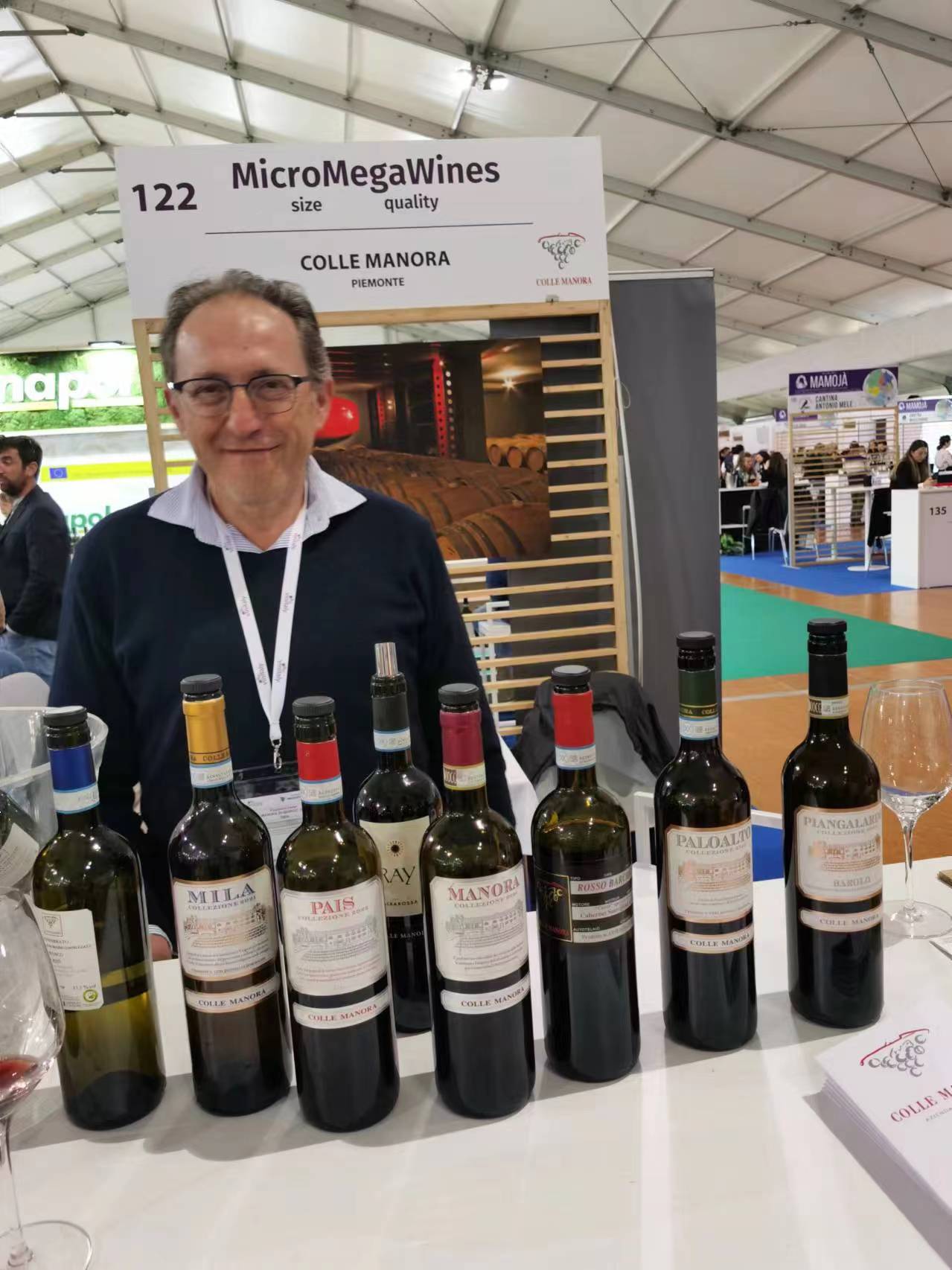
Colle Manora.
Colle Manora 2023 Mimosa Monferrato Bianco 91
Bright straw yellow. Sage, passionfruit and grapefruit on the nose and in the mouth. Finishes long and layered. Lovely, very good example of Piedmontese Sauvignon Blanc, but in a style reflecting the hot year, so with greater size than usual, despite Mimosa’s typical freshness (the vines are northeast-facing) still being present. Drinking window: 2024-2025.
Colle Manora 2022 Mila Monferrato Bianco 90
Good deep straw yellow. Aromas and flavours of peach, pear, banana and sweet spices. Closes long, pure and fleshy. This is another bigger than usual wine in keeping with the hot year, but unlike the 2023 Mimosa here the wine is a little less vibrant and rounder. Those who like broad, ripe, low acid wines will like this more than I. From the Tre Querce vineyard (or Three Oaks, in English), this is a blend of 60% Chardonnay and 40% Viognier where the former is barrel fermented and the latter sees only stainless steel. Drinking window: 2024-2026.
Colle Manora 2022 Barbera Pais Monferrato 92
From a single vineyard (Vigneto del Bosco), a lovely Barbera wine that is bursting at the seams with crunchy fresh fruit. It lingers long on the bright juicy finish. Knockout lively Barbera that will match well with any sausage and fattier meat you can think of. Drinking window: 2024-2027.
Colle Manora 2021 Barbera d’Asti Superiore Manora 94
Good full ruby-purple. Spices, red and blue fruit, balsamic oils and violet jump from the glass. The pretty, deep aromas and flavours are fresh and ripe at the same time. Closes long and bright, extremely focused and fresh on the aftertaste. Aged twelve months in large oak barrels. This is excellent: you won’t find too many better Barbera wines than this one in the 2021 vintage. Drinking window: 20-20.
Colle Manora 2020 Albarossa Ray Piemonte 93
Bright deep red. Perfumed aromas of spicy tobacco, ripe red cherry, plum and cracked black pepper. Then similar flavours, with a nice suave mouthfeel but penetrating freshness and variety-accuracy. Aged in stainless steel only for twelve months, this is at once layered and juicy, with added interest coming from the underlying peppery and sweet spiciness. I have written this before, but for my money, the Ray is not just Colle Manora’s best wine, but one of the most interesting red wines made in Piedmont today. And I think the warm 2020 vintage, rather than harm by depressing Albarossa’s natural aromatic perfume, has added instead layers of creaminess making for an even better wine than usual. 100% Albarossa (a crossing of Barbera and Chatus). Drinking window: 2024-2030.
Colle Manora 2020 Barchetta Monferrato Rosso 93
Deep ruby. Cedar, coffee and plum dominate the nose. Then more sweetly spicy in the mouth, with hints of lavender and iris adding lift. Closes creamy but lifted: though it will age another six-seven years without problems, this is very enjoyable right now. No doubt, this is a big ripe wine that showcases to full effect the growing season’s heat, but in the case of the Bordeaux varieties (Barchetta is a Cabernet Sauvignon and Merlot blend that ages about eight months in barriques) the heat didn’t hurt any. Smooth, rich and layered, this strikes me as one of the better Barchetta wines of the last few years. Drinking window: 2025-2030.
Colle Manora 2019 Pinot Nero Palo Alto Monferrato 91
Very pale red colour and so very Pinot Noir: pretty! Then also pretty on the nose and in the mouth, with juicy floral red berry aromas and flavours that are complicated by delicate herbal nuances. Closes medium-long and fresh: maybe not the last word in complexity, but this fresh, uncomplicated, easygoing red is really a pretty good Pinot Noir wine, which isn’t exactly common coin in Piedmont. So well done. Keep in mind the previous Pinot Noir wine from Colle Manora dates back to the 2016 vintage, as none was made in 2017 and 2018. Drinking window: 2024-2027.
Colle Manora 2019 Barolo Piangalardo 94
Very pretty medium-pale red colour. Crisp, fresh aromas of sour red cherries and red berries, nicely focused by a lively violet topnote and a hint of balsamic oils. Juicy but smooth, this Barolo is pure and light on its feet, but boasts smooth powerful tannins in the typical style of Monforte. The very precise flavours that echo the aromas linger nicely on a long, clean, mineral-tinged finish. Really quite good. The grapes are sourced from the west/southwest-facing Lontano vineyard in the Monforte territory. Drinking window: 2027-2038.
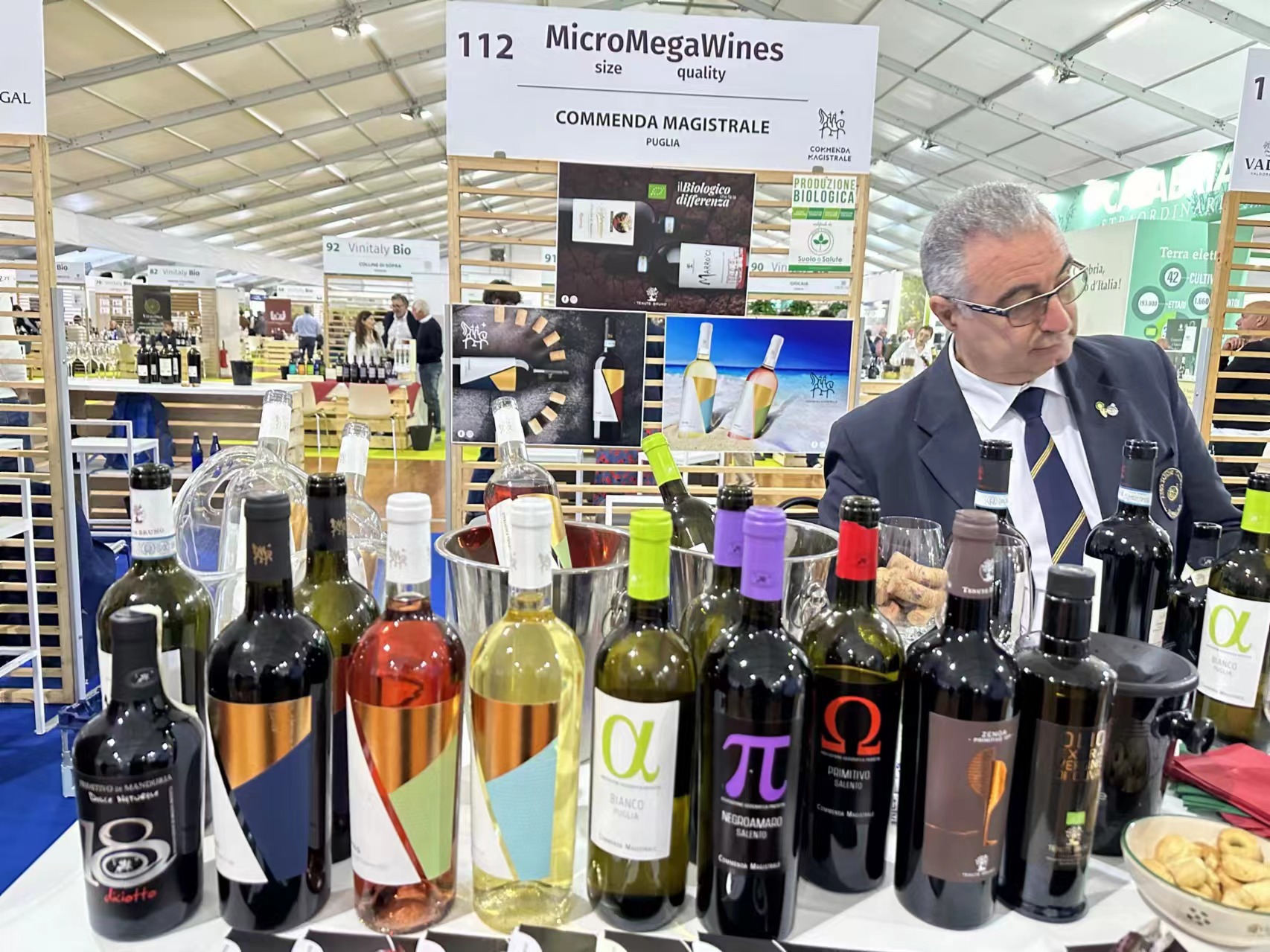
Commenda Magistrale.
Commenda Magistrale 2023 Bianco Alfa Puglia 91
Bright straw-green. Tropical fruit, apricot and lime on the zippy nose. Light and lively, with plenty of juicy orchard fruit charm and a hint of lemongrass. The t is at once suave and fresh. A roughly even blend of Fiano and Malvasia Bianca, this is juicy, fresh and long. Will make a lovely summertime sipper or a great aperitif wine anytime. Drinking window: 2024-2025.
Commenda Magistrale 2023 Bianco Mater Salento 90
Medium deep straw yellow. Peach and apricot plus a hint of lemongrass and of spice. Smooth and fresh at once, with a very long suave and slightly peppery aftertaste. A blend of Malvasia Bianca, Trebbiano Toscano and Pinot Bianco, this is bigger and more textured but less refined than the Alfa Puglia Bianco from this winery, but both are excellent wines and each will have its fans. Drinking window: 2024-2025.
Commenda Magistrale 2023 Rosato Avolo Salento 91
Bright deep pink. Red berries, tobacco, violet and cinnamon on the nose and in the mouth. Closes long with suave mouthfeel enlivened by zippy acidity. A blend of Negroamaro, Malvasia Nera and Primitivo, there’s a lot of wine for the money here: given how insipid many Rosé/Rosato wines are, this is a gem; if nothing else you’re not getting the usual notes of bubble gum, banana and little else. Drinking window: 2024-2025.
Commenda Magistrale 2021 Primitivo di Manduria Palù 93
Good full lustrous ruby. Ripe red cherry, dark plum reduction, tamarind and a hint of soy sauce. Then smooth and layered, with an underlying austerity thanks to smooth but strong tannins that nicely frame the very creamy red and blue fruit flavours. Closes long and with refined. This is one serious Primitivo, that will have many fans: these roughly twenty years old Primitivo vines are planted in the eastern part of the Taranto territory on red soils, that are known to give some of the richest, deepest but also elegant Primitivo wines. Well done. Drinking window: 2024-2028.
Commenda Magistrale 2020 Negroamaro Pigreco Salento Puglia 88
Dark ruby-red. On the nose, this seems slightly tired and oxidized, with flat, musty nuances to the red fruit and herb aromas. Then much better in the mouth, showing surprising verve and lift to its dark cherry, spice and licorice flavours. Closes juicy and fresh, with very good length. I don’t know what to make of the nose, so my final score is an average of my scores for the aromas (85) and the flavours (91). Drinking window: 2024-2026.
Commenda Magistrale 2020 Primitivo di Manduria Racemus 92
Deep ruby-red with some garnet. Ripe aromas of blueberry, strawberry, tobacco and chocolate milk, enlivened by orange peel reminders. At once broad and fresh in the mouth, this offers layered flavours of berries and cherries complicated by minerals and spices. The finish is long and suave. Organically and biodynamically farmed, roughly twenty years old bushvines, the wine is aged about twelve months in oak. Drinking window: 2024-2029.
Commenda Magistrale Primitivo di Manduria Dolce Naturale Diciotto 94
Bright ruby with hints of garnet. Knockout musky nose combines blueberry, raspberry, violet, sweet spices, marzipan and leather. Suave and utterly fine-grained, showing intense and polished flavours of black and red fruits, plus a touch of macerated figs and fine leather. Closes with noble if palate-saturating tannins and outstanding persistence. A really knockout sweet Primitivo wine that lingers long and clean with repeating echoes of raspberry and blueberry. Drinking window: 2024-2030.
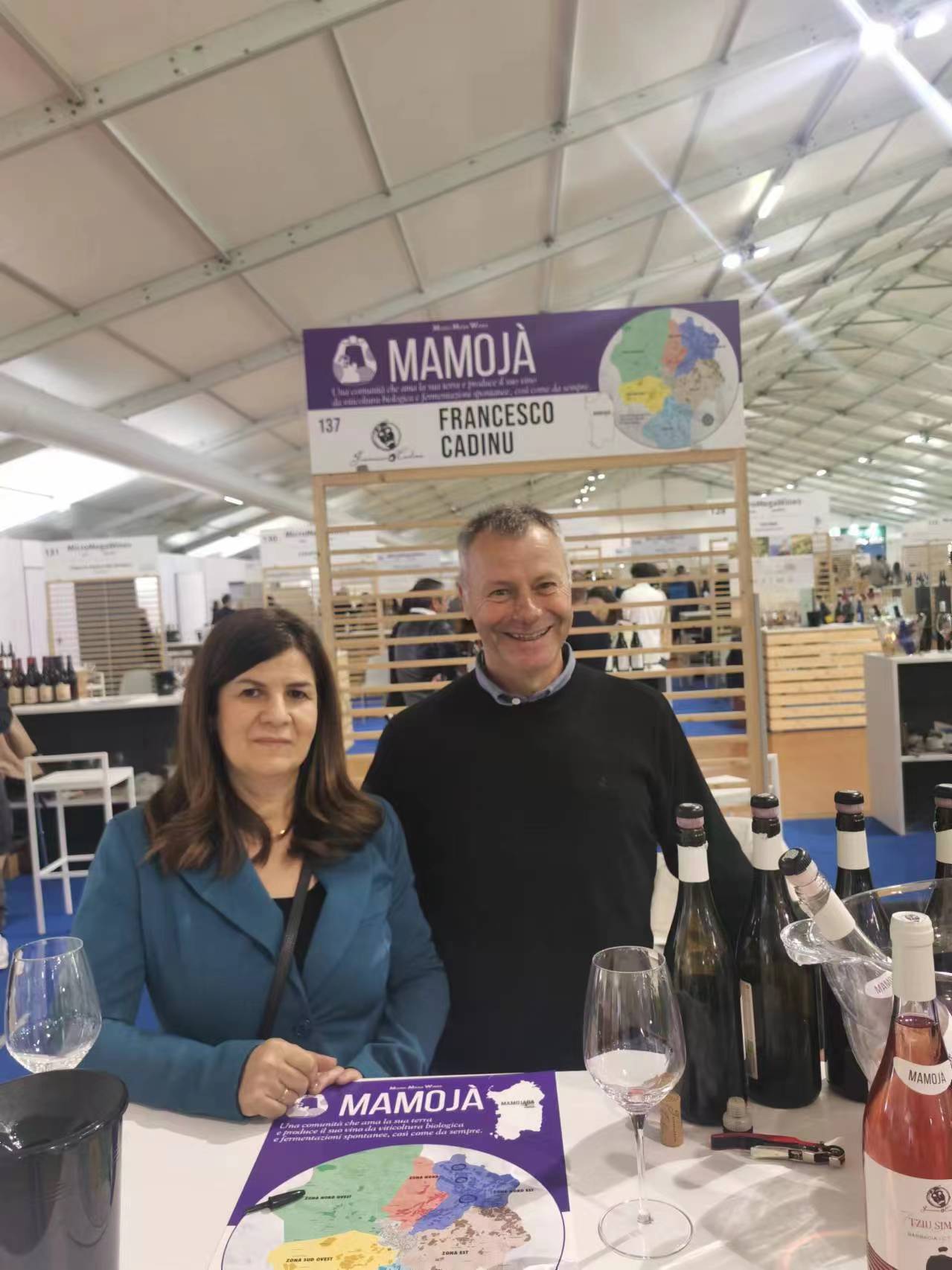
Francesco Cadinu.
Francesco Cadinu 2023 Barbagia Rosato Simone Tziu 90
Vivid pinkish red colour. Strawberries, lavender, peony and candied violet on the nose and in the mouth. Very fresh long and lovely, so chalk up another winning Rosato from Cadinu, who strikes me as being especially gifted with this colour of wine. Drinking window: 2024-2025.
Francesco Cadinu 2022 Cannonau di Sardegna Perdas Longas 88
Deep red. Aromas and flavours of spicy red fruit and tobacco, with a string musky herb component. Quite wild, even raw on entry, then sweeter and smoother in the middle, but showcases a hint of a wild streak once again on the finish. I’d suggest forgetting about this in the cellar for another year and see if the tannins gain a bit in polish. Aged one year in trunco-conical 20 hectoliter barrels. Drinking window: 2025-2028.
Francesco Cadinu 2022 Cannonau di Sardegna Ghirada Elisi 93
Bright deep ruby. Aromas of strawberry, blackberry, licorice pastille and herbs are accentuated by flowers and pepper. Enters sweet and highly concentrated, then seamless and superripe but fresh too, with harmonious acidity and a light peppery quality providing further lift. Almost sweet on the very ripe and long finish. This tastes as if a little residual sugar was left, perhaps in an attempt to keep the alcohol-derived octanes down. Made from eighty years old vines, it’s a delicious, almost Amarone-like red that will have plenty of fans. Unfortunately, there were only 1000 bottles made. Drinking window: 2024-2030.
Francesco Cadinu 2022 Cannonau di Sardegna Ghirada Fittiloghe 88
Bright saturated red. Precise aromas of red cherry, black pepper, violet, licorice and orange peel. Juicy but creamy too, offering a lovely balance of red fruits, spices and herbs on entry, but turns tougher in the middle and on the finish. Closes with serious tongue-dusting tannins, hints of herbs and licorice and very good lift, but this is really very tannic and ends with a rising bitterness that may not be for everyone. I am not sure what to think: I really liked the previous vintage of this wine, a unique red made from roughly 120 years old Cannonau vines. Aged for one year in 700 liters chestnut wood barrels: I’m all for tradition, and I would hate to see these chestnut wood barrels disappear, but I think the duration of aging has to be modified somewhat or at least better tailored to the vintage’s characteristics, so as to avoid ending up with that hint of bitter and drying tannins. You can try cellaring a few years and see if it smoothens out, but I wonder. Drinking window: 2027-2032.
Francesco Cadinu 2022 Cannonau di Sardegna Ghirada Loreto 94
Good full ruby-red. Inviting aromas of red fruit, licorice and minerals have a bright floral topnote. Rich and ripe in the mouth, with nicely sweet flavours of raspberry and candied violet nicely framed by suave, polished tannins. Very long on the fresh, smooth finish. This gorgeous wine, made from 100 years old vines, offers superb potential. This was also aged twelve months in chestnut wood barrels,. but unlike with the 2022 Fittiloghe Cannonau form this winery, this is sooth and polished and shows no bitterness whatsoever. At less than 14% alcohol, it is also another example of a Cannonau wine from Mamojada produced with the precise goal of it being well-balanced, easy-drinking and approachable when young, though the hint of residual sweetness may not be for those who love bone-dry wines. From the northeastern subzone of the production zone that tends to give more balanced, austere classic red wines. Drinking window: 2026-2031.
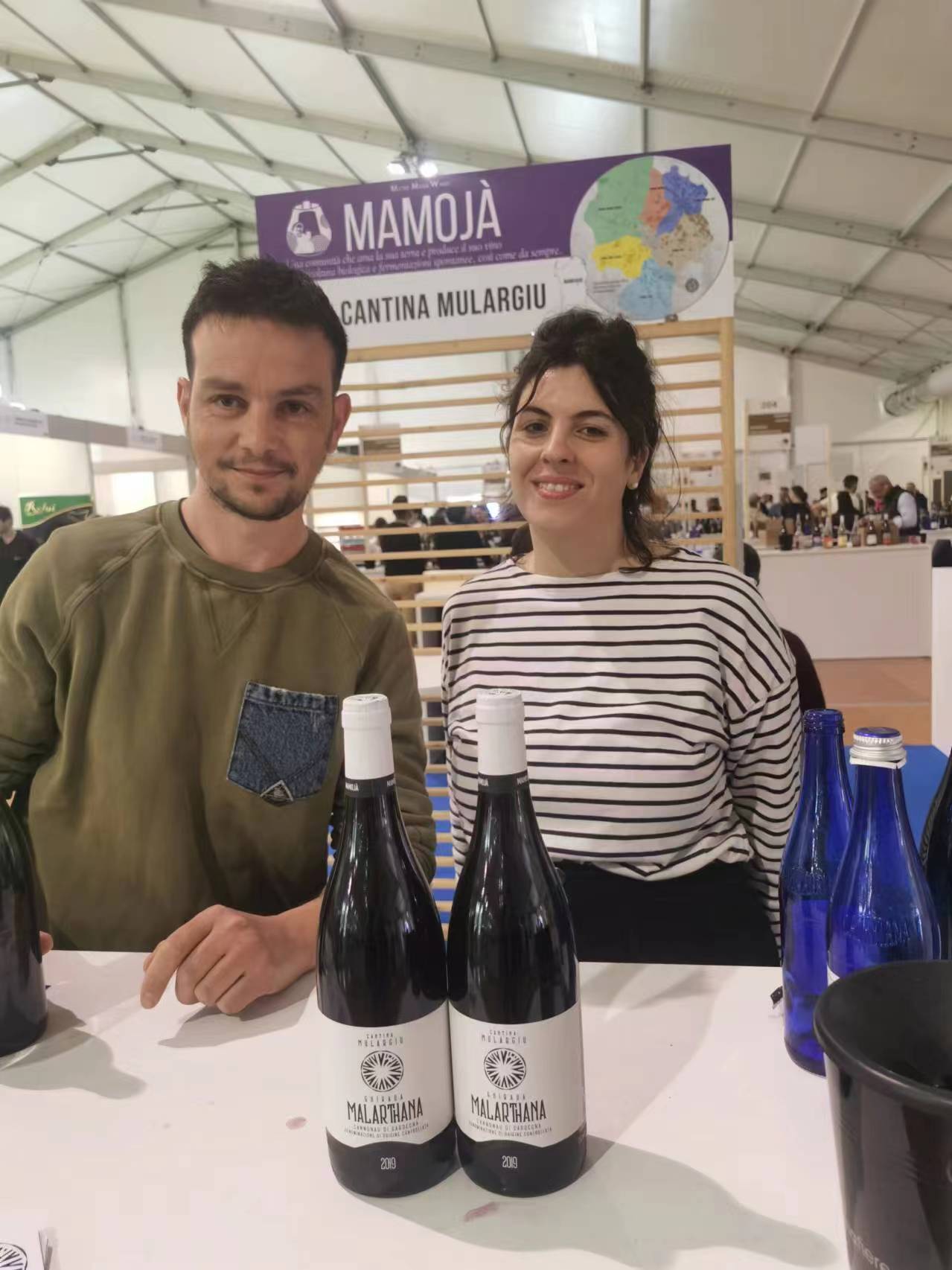
Francesco Mulargiu.
Francesco Mulargiu 2022 Cannonau di Sardegna Ghirada Malarthana 93
From the northeastern subzone of the Mamojada, a very fresh, lively red that offers aromas and flavours of strawberry, raspberry and red cherry, before veering towards herbs and spices. A tannic note emerges with aeration on the long vibrant finish. This is really delicious and will prove very flexible at the table. Drinking window: 2026-2030
Francesco Mulargiu 2021 Cannonau di Sardegna Ghirada Malarthana 94
Ruby-purple. Strawberry, ripe raspberry, and red cherry are complicated by violet pastille, rose petal and licorice. Fresh and loaded with sweet fruit, but with a building firm mineral spine nicely framing the deep fruit flavours. Youthfully chewy and pliant, this is already good to drink now, but offers enticing glimpses into its future potential. The aftertaste is very long and offers subtle inner-mouth floral qualities. This is really outstanding and one of the best wines I tried from the Mamojada this year. From a roughly fifty-fifty blend of grapes picked from twenty- and eighty-years old vines, this was aged one year in cement and another eighteen months in bottle prior to going on sale. Drinking window: 2026-2031.
Francesco Mulargiu 2020 Cannonau di Sardegna Ghirada Malarthana 1909 96
Full ruby-red. Enticing aromas of strawberry, red cherry, licorice, menthol and orange peel. Densely packed and silky, with superb intensity and concentration to the refined spicy red berry flavours. Wonderfully silky and velvety wine with terrific lift and sappiness but with a very firm underlying spine of noble tannins and harmonious acidity that really support and extend the flavours. Closes with sweet, building tannins and superb fruity persistence. This is remarkably rich, and pliant finishing smooth and multilayered. From a small 0.5 hectares plots of 115 years old Cannonau vines, this was aged in third-fill tonneaux where it spent eighteen months. Mulargiu doesn’t like the taste of oak in his wines and tends to avoid using it if he can, but in this case the volume of old-vine grapes he had to work with was just too small to be able to use anything but a tonneau. A gorgeous wine, it will be on sale towards the end of the year. Drinking window: 2026-2031.
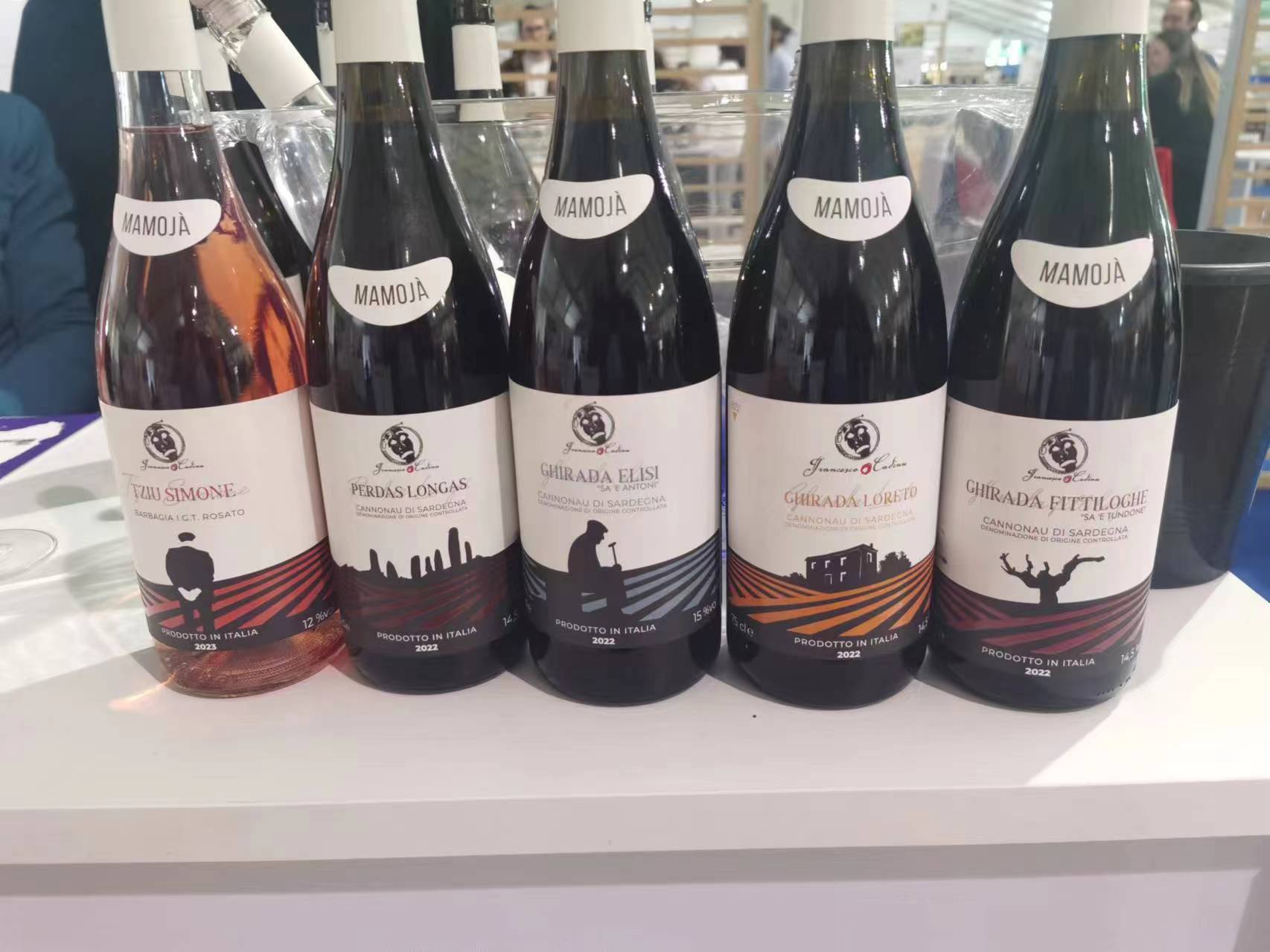
Il Casale della Regina.
Il Casale della Regina 2023 Acquae Sexiae Lazio 91
Bright straw yellow. Delicate, fresh aromas of apricot and peach dominate the nose. Much richer, deeper and fruitier than the 2022, a warm year. This blend of Pampanaro, Maturano and Campolongo stayed six months on the lees, which helped it develop gain better palate presence. This is really very promising. Drinking window: 2024-2028.
Il Casale della Regina 2022 Cicero Lazio 90+
Medium deep yellow gold. Apple and pear are complemented by a note of eucalyptus and balsamic oils on the nose. Rich, textured and monolithic in the mouth currently, this has plenty of freshness coupled to noteworthy structure. Finishes long and clean, leaving a tactile impression behind. A new wine from this winery, and to the best of my knowledge the only 100% Maturano wine made in commercial viable numbers in Italy (and still, only 1000 bottles of this first vintage were made). As Maturano isn’t the easiest variety to get to ripen fully, and much depends on the seasonal weather, it gives very different wines from year to year. For a first-time effort, I think they’re on to something here, but I would give this another year in the cellar, and two might be better, to let it blossom further. Drinking window: 2026-2030.
Il Casale della Regina 2022 Ladislao I Lazio 90+
Deep ruby-red. Intense nose of plum (the local plum, called lecina, is famous), red cherry herbs and even a hint of balsamic oil. Fresh and juicy, with a lively texture and rising smooth tannic spine that provides plenty of support. A blend of 60% Lecinaro and 40% Cesanese d’Affile that are slightly late harvested (end of September) and aged in new and one used oak barrel. In the future Di Ruzza hopes to make a 100% Cesanese wine aged in 10 HL used oak barrels. Drinking window: 202-203.
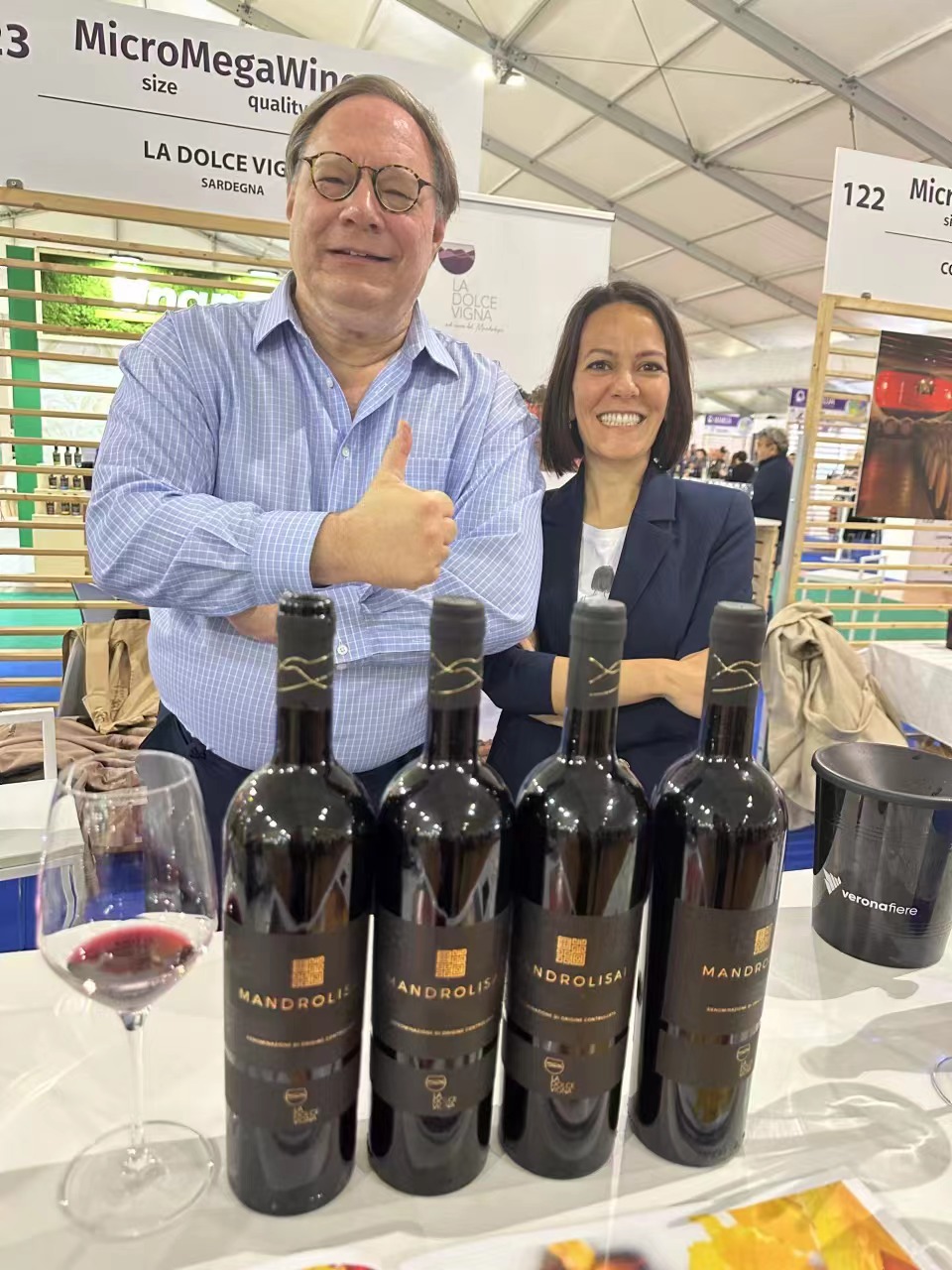
La Dolce Vigna.
Antonellaaaaaaaaaaaaaaaa! What a sun beam of talent, steely resolve, and quiet grace this young lady turned out to be when I first met her this year. Normally I meet producers for the first time at a winery, but occasionally I first run into them at a wine fair, as was the case with Antonella Pisu. She’s the owner and driving force behind La Dolce Vigna, one of the best new wineries I have discovered in the last ten years. Yes, folks, this winery really is that exciting: unfortunately, only one wine is made, and in small volumes to boot (after all, that’s the title of this report, so it would be strange if I were to write otherwise).
The 2023 Mandrolisai will be out in 2025 and it’s another promising wine; production saw a small pick (3500 bottles available, with the potential to reach 9000/year one day).
La Dolce Vigna 2022 Mandrolisai 94
Good full red-ruby. Perfumed aromas of violet, red cherry and sweet spices recall Nebbiolo somewhat; a complicating note of Mediterranean scrub and blackberry reduction create further interest. Enters creamy and suave, then juicier in the middle, with lifted, nicely focused and lingering red and blue fruit flavours that spread out evenly to coat the entire mouth. A field blend of 50% Bovale Sardo, 25% Cannonau and 25% Monica (co-planted together and then co-harvested together), this is fairly good to go, but will age well in a good cellar. The Bovale Sardo is the main grape variety of the area, and it confers colour and tannin; Cannonau provides elegance and flesh, while Monica (one of my favourite Italian native red grapes, for what it’s worth) supplies freshness and drinkability. Indigenous yeatts only, no additives (just a little sulfur dioxide prior to bottling), nine months in French oak tonneaux and then another eight to ten in bottle before going on sale. The 2022 vintage was an especially good one for this wine. It’s only the third vintage made (the first vintage was 2020): unfortunately, it’s still only made in homeopathic quantities (ie. there’s only about 3000 bottles a year currently), a real pity given this Mandrolisai is an absolute knockout. So I upped its score after retasting it a third or fourth time: not that I needed convincing, it just got to a point where I realized I was being needlessly stingy. Drinking window: 2025-2034.
La Dolce Vigna 2021 Mandrolisai 93+
Medium red-ruby. Cool aromas and flavours of dark berries, plums, and iron shavings, with a violet topnote. Taut, even austere, in the mouth, this refined wine finishes long and pure, with slightly tougher but still noble tannins compared to the creamier 2022. The aftertaste is long and clean. A field blend of 50% Bovale Sardo, 25% Cannonau and 25% Monica (co-planted together and then co-harvested together), this should be cellared for a few years more to enjoy it at its apex, and will then age well for another decade or so. The Bovale Sardo is the main grape variety of the area, and it confers colour and tannin; Cannonau provides elegance and flesh, while Monica (one of my favourite Italian native red grapes, for wat it’s worth) supplies freshness and drinkability. Indigenous yeatts only, no additives (just a little sulfur dioxide prior to bottling), nine months in French oak tonneaux and then another eight to ten in bottle before going on sale. The 2021 vintage was a very hot one in the area: it follows that this wine boasts more octanes than the 2022 (15% versus 14.5%), but the viticulture and vinification here are such that you won’t notice that alcohol at all). Speaking generally and with some leeway, this is more Bordeaux in style compared to the 2022’s Burgundy. Both are excellent wines. Drinking window: 2027-2035.
Lasorte Cuadra.
Lasorte Cuadra 2022 Bianco Silos Valle d’Itria Puglia 92
Bright clean fresh and layered with sneaky concentration and complexity A single vineyard wine that is a blend of roughly 60% Verdeca, 20-25% Bianco d’Alessano, 10% Maresco and 5% Minutolo (all local white grapes of Puglia’s Valle d’Itria) that spent four days on the skins and nine on the lees.Drinking window: 2024-2026.
Lasorte Cuadra 2021 Bianco Silos Valle d’Itria Puglia 91
Medium straw yellow. Herbs and honey dominate the nose. Then a slight honeyed nuance complements the flavours of apple and green apricot in the mouth too. A blend of Verdeca, Bianco d’Alessano, Minutolo and Maresco (all local white grapes of Puglia’s Valle d’Itria) that spent four days on the skins and nine on the lees, this tastes remarkably different from the 2022 Silos. As almost always the case, the grapes were harvested around September 26-28. Drinking window: 2024-2026.
Lasorte Cuadra 2020 Bianco Silos Valle d’Itria Puglia 92
Bright straw-green. Intense nose calls Vermouth to mind, speaks clearly of the presence of the Verdeca grape variety; nuances of white flowers, orchard fruit and minty herbs are precise and clean. Then very fresh and well-balanced in the mouth, with hints of buttered toast and hazelnut in the background. Long and fresh on the juicy finish. Call it beginner’s luck, but this is delicious and head-turning: 2020 was the first vintage ever made of Silos, a very promising blend of Verdeca, Bianco d’Alessano, Minutolo and Maresco (all local white grapes of Puglia’s Valle d’Itria) that spent four days on the skins and nine on the lees. Still, this doesn’t taste needlessly chewy like far too many skin-contact wines, but that minimal skin contact did allow for greater flesh and perfume. Very, very well done here. Try it, you’ll like it! Drinking window: 2024-2025.
Lasorte Cuadra Epopira Dry Cosma 93
Can it really surprise that a winery in tune with its terroir (and the history of it) decided to also make two different vermouths (one dry, one sweet)? That’s the sort of attention to detail and studious approach that Stephanie Cuadra and her husband have brought to their pet project in Puglia, where they are making not just great white wine, but two Vermouths that will knock your socks off.
Deep yellow with golden nuances. Highly aromatic, piercing aromas of orange peel, quinine, cinchona bark, grapefruit and vanilla. Fresh and vibrant with a bitter sweet nuance to the rich ripe and sweet flavours. Made with twenty-three different botanicals left to infuse individually in the Silos white wine. Listen, if you like Vermouth, you owe it to yourself to find this bottle and its stablemate, the sweet Vermouth.
Lasorte Cuadra Epopira Vermouth Dolce 92
Very similar to the Dry Vermouth, but noticeably sweeter, this is perfect if u like a touch of sweetness in your aperitifs and digestives: well then, in this case you have certainly found the right one for you; this is drop-dead gorgeous. Rose petal, candied violet, quinine, cinnamon, tobacco and talc give way to an unctuously sweet but lifted mouthfeel that lingers impressively on the herb-accented finish. Pour over the rocks and enjoy all night long.
Mertzeoro.
Mertzeoro 2023 Barbagia Bianco 91
Bright starw with some gold. Smells and tastes very fresh, then raisiny, with balsamic nuances to the grapefruit and pear aromas and flavours. Closes long and juicy with a whiplash of freshness. Spent six months in stainless steel. Drinking window: 2024-2026.
Mertzeoro 2023 Barbagia Rosso 89
Bright red, Field greens, red cherry, minerals and tobacco on the lifted nose. Very high acid mouthfeel, in fact, this comes across as being almost shrill. First year this wine was made so I’m hoping future vintages show better balance. Drinking window: 2025-2027.
Mertzeoro 2022 Barbagia Rosso Ghirada Baduorane 95
Bright medium ruby. Highly perfumed, downright sultry aromas of raspberry nectar and cassis, lifted by hints of licorice, violet, cinnamon and minerals. Extremely primary and very pure, with sharply delineated cassis, red berry and mineral flavors of utter class and precision. Conveys a rare lightness of touch for a Cannonau wine, while finishing nicely subtle on the long back end. Aged twelve months in tonneaux, this is very typical of the Cannonau wines from the Mamojada’s northwestern subzone, that tend to be all over the board stylistically (more so than with other subzones) but that all share elements of refinement and smoothness without reaching behemoth levels of fleshiness (the high altitude at which these vines grow no doubt contributes to this impression and mouthfeel). Very interesting wine. Drinking window: 2026-2031.
Mertzeoro 2022 Barbagia Rosso Ghirada Mulinu 93+
Deep ruby-red. Clean, fresh aromas of superrirpe red and dark cherry, small black fruits and potpourri. Very rich, round and spicy, with similar flavours to the aromas, this shows mounting tannic heft on the long, tactile finish. In my experience, the tannic note is very typical of the Mulinu ghirada (by contrast and for example, it’s fairly well absent from Mertzeoro’s wine made in the ghirada Baduorane). Aged in used barrels. Drinking window: 2026-2033.
Montisci Vitzizzai.
Montisci Vitzizzai 2023 Granazza Cara Mala Barbagia Bianco 90
Bright golden-tinged straw yellow. Aromas and flavours of ripe orchard fruit (pear, especially) and despite the absence of oak aging, this smells and tastes of toasted coffee beans. From grapes grown in the northern area, Simonetta’s vines are near the church below 730 meters above sea level. Drinking window: 2024- 2026.
Montisci Vitzizzai 202 Barbagia Rosato Istimau 90
Pale pinkish-red. Perfumed aromas and flavours of red cherry, purple flowers, thyme, and other botanicals. Long and layered, with very little in the way of tannins and features a long suave finish. Drinking window: 2024-2025.
Montisci Vitzizzai 2021 Barbagia Rosso Istimau 89
Luminous deep ruby. Very pretty aromas of violet, red cherry, red berries and herbs. Then more mintiness in the mouth, with fresh, zippy flavours of red fruit and Mediterranean scrub. The building tannins have a slightly gritty mouthfeel and leave an impression of underlying astringency. Istimau is made with grapes picked from the estate’s youngest vines and aged in 3000 liter barrels, but this specific vintage does not seem to me to be as successful as last year’s version, for example. I’m a big fan of Montisci Vitzizzai, which I really think is one of Barbagia’s best producers, but I suggest you try this estate’s Ghirada Foddigheddu wine, made from 80 years old vines, that is a real knockout this year. Drinking window: 2026-2031.
Montisci Vitzizzai 2021 Barbagia Rosso Ghirada Foddigheddu 94
Dark red. Decadently ripe but not overripe or jammy red cherry flavour, plus hints of marzipan and a late hit of herbs on the long suave finish. This is a very beautiful, round, smooth wine made from 80 years old vines, and that old vine reality shows through at every sip. Very velvety tannins and bursting with gorgeously decadently ripe red cherry fruit. Drinking window: 2025-2032.
Muggittu Boeli.
Muggittu Boeli 2022 Barbagia Rosso Boeli 93
Bright medium ruby. Ripe but nicely piercing aromas of strawberry, raspberry, lead pencil and espresso, plus an exotic suggestion of tangerine. Thick and impressively concentrated, with lovely clarity of red cherry flavours that are full, deep, lush and very long. Very differently from Vinzas Artas, at Muggittu Boeli they aim to make classic, rich Barbagia wines and so pick late and when grapes are fully ripe. These grapes were sourced in northwestern subsone. This beauty sports 14.5% alcohol, but the wine is so well-balanced it doesn’t seem like it has that much alcohol at all. Well done. Drinking window: 2027-2032.
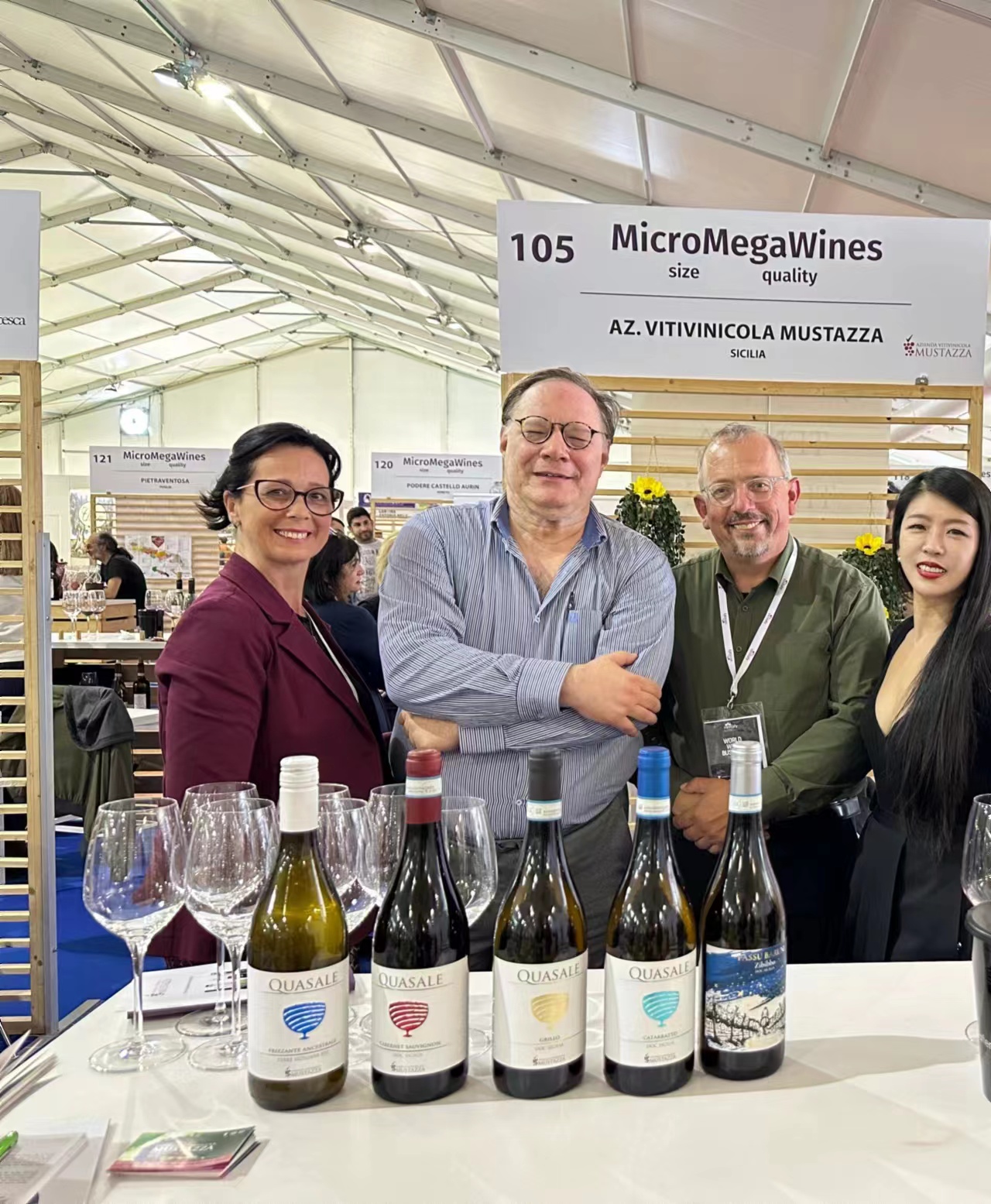
Mustazzavini.
Mustazzavini 2023 Cataratto Quasale Sicilia 90
Pale straw. Flowers and apple on the nose.-Fresh and long, this strikes me as noticeably sweet on the finish, perhaps a result of the highly concentrated grapes (40% less production in this vintage) that packed in more sugar than usual. I’m scoring it a little lower than I would normally because to my taste, this is bordering on sweet, but have no fear, it’s a gorgeous easygoing white wine . Drinking window: 2024-2026.
Mustazzavini 2023 Grillo Quasale Sicilia 92
Bright pale straw. Aromas of fresh cut grass, but mostly it was pineapple and apricot. Then bright and layered, wth saline nuances speaking of the Grillo g+harvest in 2024. Fresh and savoury, this excellent wine by Mustazzavini transmits what Grillo is all about: a clean fresh wine with piercing personality that does not have to be left residually sweet or oak camouflaged to get it to show its best. Drinking window: 2024-2026.
Mustazzavini 2023 Zibibbo Sicilia 93
Bright straw green Outstanding Zibibbo varietallky accurate aromas and flavours of raisins, grapefruit, cane sugar, and peach. Long and fresh. Brand new wine for Mustazzavini, this is the first vintage of Zibibbo and a real winner that will be loved by anyone who tries it. Stainless steel only, this sees no oak. Unfortunately, there’s only 2000 bottles made of this first-time effort. Drinking window:2024-2026.
Mustazzavini 2021 Cabernet Sicilia 90
Deep red. Graphite, ripe blackcurrant and p0liums plus some violet on the bright nose and mouth. Finishes long and savoury. Lovely ripe Cabernet Sauvignon wine. Drinking window: 2025-2030.

 中文
中文

